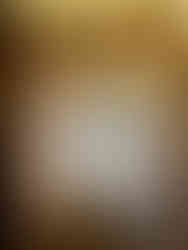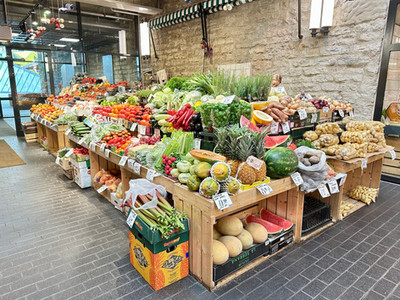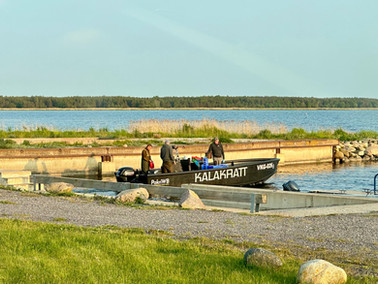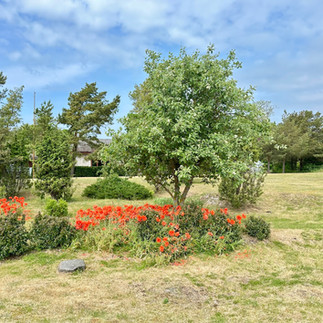Estonia - Part 2 - Meeting the KGB
- zigzaggingtheworld
- Jun 15
- 9 min read
The rain had returned as we headed towards the capital city of Tallinn. On the way to our planned parking spot by the ferry terminal at the port, we stopped off to have a look at the Memorial to the Victims of Communism which is dedicated to all those who suffered under the communist terror regime and were murdered, imprisoned, or deported between 1940 and 1991 - the numbers totalled well over 100,000 which was basically every fifth person of a population that was only just over a million. The memorial consists of two parts – the Journey with plaques bearing the names of those who perished in the terror, and the Home Garden, to which are added location stones with information texts marking the locations where the terror was carried out. A monument to Estonian officers who fell victim to the communist terror is also part of the Memorial. The information plaques made sombre reading as always, with the dark damp weather adding to the atmosphere.
This striking memorial was erected in 2018 and was erected next to the Soviet built Maarjamäe Soviet Memorial Complex dedicated to those who had fallen when defending the Soviet Union during World War 2. The monument has been left to decline and is covered in graffiti.
At this site there is also a National History Museum which was closed when we visited but we could access the graveyard for old Soviet statues which have been rounded up from their original positions in the city and placed here for posterity.
Our parking was just a 15 minute walk from the old town, and we got wrapped up and headed there ready for a walking tour we'd booked for that afternoon ensuring we had time for a coffee and bite to eat first.
The walking tour was a fantastic introduction to Tallinn and to learn more about Estonia. Our guide Marko, a history teacher at a local school, does these 'free' guided tours of the centre of Tallinn to share his passion for the city. He started with a simple chart of Estonian history which showed Estonia's chequered past of occupation by the Danish, Swedes, Russians and Nazis . Estonia finally got their first real independence in 1918, but this was short-lived with the USSR occupying them yet again from 1940 until 1991, with the short spell of Nazi occupation in between. So as Marko clarified this current spell of independence is the longest they have ever managed.... so far!.
His tour concentrated on the upper part of the old town and his enthusiasm was infectious and he kept us gripped for the 2 1/2 hours. It is a stunning city, much more touristy than Vilnius but a lovey place to wander around the back streets, main squares and take in the views from the hill. We were happy to 'tip' him at the end which is how these free tours work.
After the tour we visited the oldest Pharmacy in Estonia then walked across to the Balti Jaam Market near the station which is covered market selling fresh fruit and veg, but with eateries, and some antique an clothing shops thrown in for good measure.
We walked back to the old town to get dinner - our first choice restaurant was full. It looked so nice we asked if we could book for the following night, but were told it was already fully booked as there was a big concert on the next evening - Imagine Dragons - are we the only people never to have heard of them?
Thankfully the following morning was bright and sunny so we set about more exploring of the city. We started by getting the Bromptons out to cycle to Kadriorg Park, where a palace and urban park sit, ordered to be built by Peter The Great for his wife Katherine in the 1700s. We had breakfast in a cafe there and enjoyed a cycle/walk around the grounds. The place is now an art museum.
We cycled back along the sea front passing the old Olympic stadium, now very much dilapidated. It was built to host the watersports for the Russian Olympics in 1980 which were largely boycotted by western nations. Marko had told us we could still find lots of souvenirs for this event in antique shops as there was no-one here to buy them in 1980.
Marko had recommended we visit the Kalamaja district to look at the colourful wooden houses that are unique here and we carried on into the Telliviski district, which is a regenerated area near the station that has now been made into a creative hub for the city.
We dropped the Bromptons back to Lo11y, then walked back into the old town. There were several museums in Tallinn where we felt we'd covered their stories in Vilnius, such as the Museum of Occupations and Freedoms and the KGB prison, however we noticed there is a KGB museum in a hotel which piqued our interest. Back in the 1970s and 1980s visitors and tourists to Russian states could only stay in one hotel chain - InTourist. The KGB would be based in all these hotels. In Tallin the Viru Hotel was a modern high rise hotel, but what people staying there and staff didn't realise was that the 23rd floor (top floor) was not a storage floor, but housed the offices of the KGB who were monitoring all the guests throughout the hotel.
With foreign guests (businessmen, journalists, diplomats, and tourists) constantly passing through, the hotel provided a prime opportunity for Soviet intelligence to monitor Westerners and gather information. The two rooms they used housed state of the art surveillance equipment. It reminded us of Q providing James Bond with cufflinks with microphones in etc. There were tape recording machines and cameras in most of the bedrooms. They also had a direct line to Moscow. They had a Babushka (little old Russian lady) placed in Lobby who was recording who came in and out of the hotel. The sign on the door below says 'Nothing to see.' In 1991 when the Soviet Union collapsed the KGB agents left in a hurry. It was then the hotel staff discovered the broken equipment and furniture that had been left behind. The tour took us into the 2 rooms on the 23rd floor which was fascinating. There were only two others with us - a Chinese girl who is at University in London and a very over made up lady who said she was from Azerbaijan where the FSB (as the KGB became) still operates there and they have to be very careful what they say or do.
After leaving the hotel we had a walk right round the old town and up the hill again to see everything in sunshine.
The town was much livelier today with the people getting ready to go to the concert. We had a drink in the main square where our waiter said he'd lived in Ipswich for a number of years while his dad was working in the UK. We then tried our luck at the restaurant we wanted to eat at (called???? )who'd told us they did take a limited number of walk-ins and we were lucky enough to be squeezed in. We had the most fantastic meal (Colin had braised elk) and the young lady serving us was super friendly and a good sales person persuading us to order bread and dessert too. The place had an interesting toilet too.
We were ready to move on the following day, so after the bustle of a big city we headed to the coast to catch a ferry out to some small quiet islands ideal for cycling around.
Our ferry was booked late afternoon, so we had a few hours at the stunning small town of Haapsalu which was built around an old castle. The main street through the town was full of cafes, bars and restaurants. We wondered how they could support so many through the year.
We had a walk around the lagoon and along the promenade and came across another fabulous cafe/restaurant where we quickly decided this should be our main meal of the day. The mussels and fresh perch were delicious.
There was a great place to park up motorhomes looking out to sea, so we moved Lo11y here and had a spin on the Bromptons up to the headland.
The ferry port was just 10 minutes drive away, and on the way we passed the old railway station which had several old locomotives that had been used in WW2 presumably carrying prisoners of war for a time.
It was an hour on the ferry to the island of Hiumaa. As it was quite late when we arrived we just drove a short distance from the ferry terminal down a dirt road and found a place tucked in the trees by the sea where we spent a peaceful night in the rain.
The following morning we drove to the main town on the island to park up and do a bike ride up to a lighthouse at the northern tip of the island. While there, Colin called in at a bank and got talking to an elderly lady who told him she had been born and brought up on the island, but when she was young her Auntie and family were taken by the Russians in the middle of the night and were deported to Siberia. They finally returned 7 years later, but obviously they were never the same again. She met a man from Finland who was working on the island and she moved with him to Helsinki, but had kept her home on the island as a holiday home. She said she was now selling it as she firmly believes Russia are going to take over Estonia again. Generally the Baltic people don't give the impression that they are scared for their future, so the lady's comments shocked us a little, but she has lived through it before.
We carried on to do the bike ride that took us out of town along cycle paths that are smoother than the roads and through forested areas dotted with old military relics. We pulled into a camping/picnic site where the white sand and crystal clear waters could have been the Caribbean. The furthest point was a lighthouse with a memorial to the largest shipwreck in post war Baltics in 1994. On the way back to town we saw an area of crosses dedicated to an old Swedish farming community who were forced to leave in the 1700s.
Back in Lo11y we continued around the island. We called in to the only coffee shop we had found open on the island which was in a strange cluster of old warehouse type buildings that seemed to be starting to be transformed into an arts hub. The lady serving us said it was a former acrylics factory, then a fishing factory.
We drove out to the westernmost point where there were more old military relics. It would have made a great spot to park for the night, but we needed to be further south to catch an early ferry the next morning. We watched a snake slither off into the long grass.
As we got back on the main roads an elk ran in front of us and a couple of deer. We ended up parking up on a small harbour area at Haldi with nice views out to sea and we watched a couple of fishing boats go out in the evening and a nice sunset.
It was just a short drive to the ferry port at the south of the island where another ferry took us to the larger island of Saaremaa where vikings had settled 5,000 years ago. We headed to the west coast to look at the Panga Cliff - the highest in Estonia. It didn't look very hight to us but the park above the cliff was very nice and the sea crystal clear.
We then drove to the capital town of Kuressaare which we loved. It has the most fantastic castle and a lovely old town.
We had a bike ride planned so after grabbing a coffee and some delicious buns we drove further down the island and found a spot to park up by the sea next to a lighthouse. We had to cycle a few miles on gravel to reach the main road, and then ride to the south of the island to the Sorve Peninsula was't the most scenic - just through forests and into the wind.
The destination was worth the effort though. There is a striking lighthouse, lots of military bunkers and a great cafe/restaurant where yet again we couldn't resist the food. We felt a bit naughty having fish and chips but they were delicious.
We had a bit of a hairy moment when we returned to Lo11y when the winch mechanism on the bike box broke due to a bolt that had sheared. We wouldn't be able to drive with the box stuck down. Thankfully Colin's logical mind saved the day and he worked out that he needed to take a bolt from somewhere else on the truck that would be a temporary fix. It also gave him the pleasure of going to a DIY store the next day - always his favourite type of shopping. We enjoyed a solitary but very wet night, but there was a beautiful sunrise at 5am.
We drove back to Kuressaare for breakfast and to walk around the castle which was everything a castle should be. There were also a few street stalls in the town selling local produce and crafts.
To get back to the mainland we had to drive over a bridge to the neighbouring island of Muhu, then take another short ferry crossing.
We continued south to the coastal town of Parnu which is dubbed as Estonia's coastal party town. It certainly was very busy as we drove into town, and we only just managed to squeeze into a central car park. We realised there was a big festival taking place - Grill Fest - with hundreds of stalls selling grilled food and drinks. We were regretting not turning up here hungry.
We made our way to the beach - a long windy stretch of golden sand - a perfect place for kitesurfing by the look of it. We debated whether to stay in town that evening, but thought it would be pretty noisy and crowded, so we continued south and before long found ourselves back in Latvia.






































































































































































































































































































































































































Comments